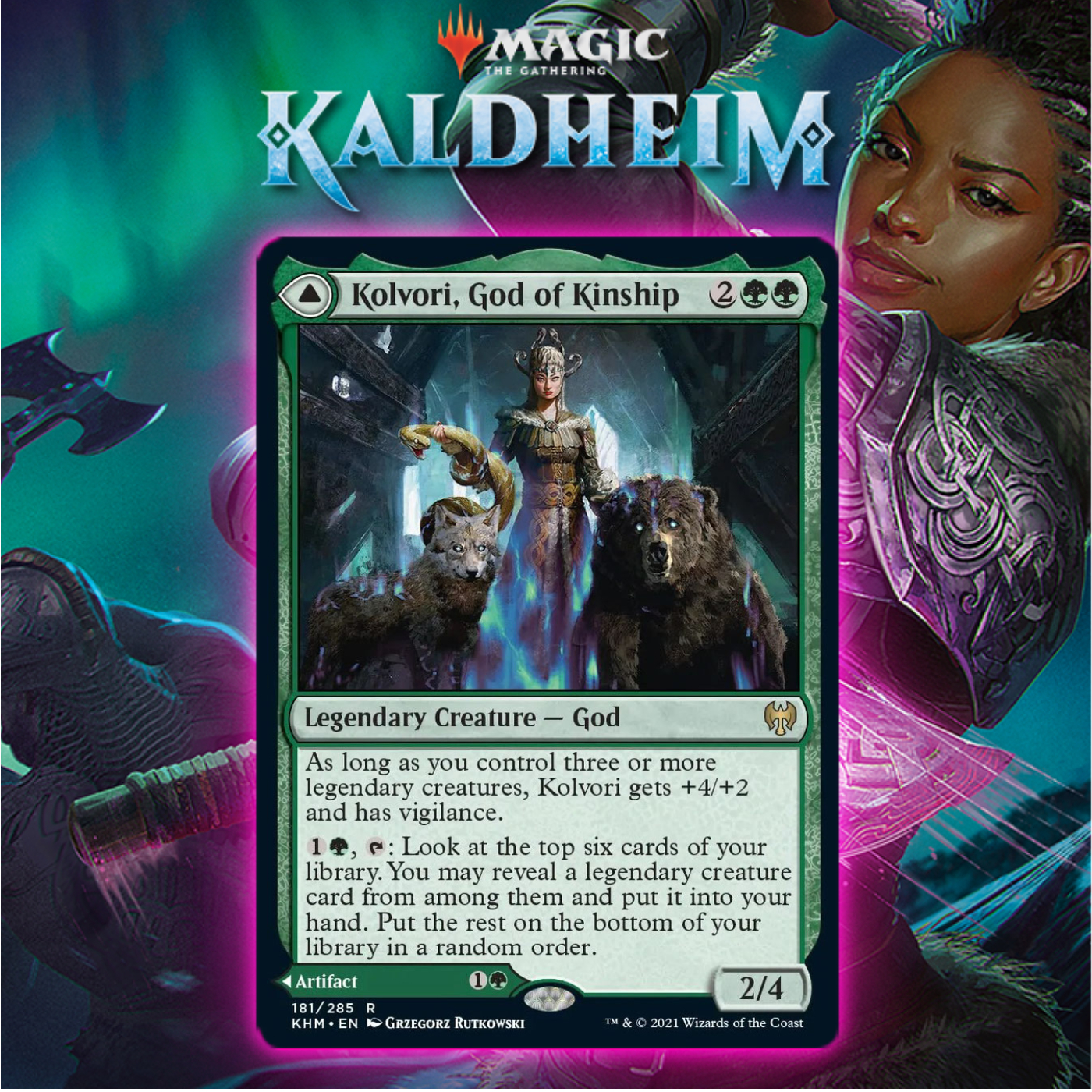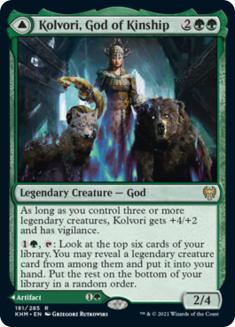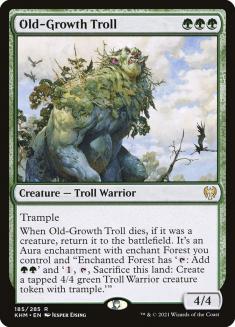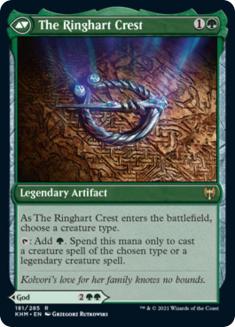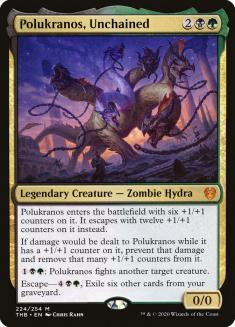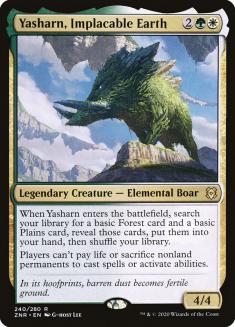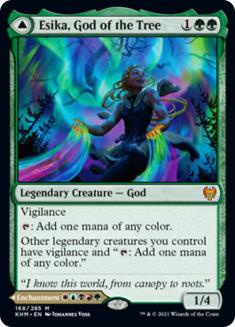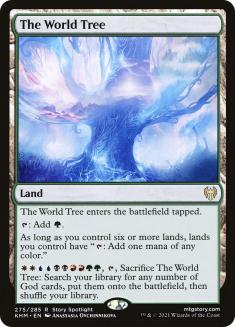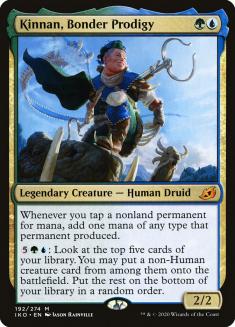Kolvori, God of Kinship made me do a double-take when I read the card, as it combines raw power, card advantage, and versatility all into one package, provided you build a deck that suitably complements its abilities. That said, there’s a lot going on here, so let’s start by breaking down this DFC one side at a time.
A 2/4 for four mana is quite bad, and it’s rare for a card with stats like this to really see play except if it has a really powerful ability. A 6/6 with vigilance, however, is great. A card with those stats would rarely be good enough on its own to see play in Standard, but in Standard environments where attacking and blocking are important, it wouldn’t be that far off and would quickly become good enough with additional relevant text and the correct home. Gruul Adventures has been arguably the best Standard deck for the last few months, so it’s fair to say attacking and blocking are both important in Standard currently, which makes the prospect of a four-mana 6/6 quite appealing to me, provided that stat-line is easy to attain and comes with other relevant text alongside it.
So how often will Kolvori be a 6/6 with vigilance? Whilst you do need to meet the requirement of having three legendary creatures on your side of the battlefield, this requirement is actually a bit easier to meet than it sounds because Kolvori herself counts towards that, meaning you only need two additional legendary creatures by her side.
If you’re on the play and want a 90% chance to have drawn at least two non-Kolvori legendary creatures by your fourth turn, then you need nineteen non-Kolvori legendary creatures in your deck. This percentage is a bit worse than it sounds, as it ignores the problem of drawing multiple copies of a specific legendary creature, but still the numbers needed to make assembling a 6/6 seem quite achievable with the right supporting cast. If you’re willing to wait until your fifth turn to have found the needed legendary creatures and are happy with a 75% chance of having Kolvori be a 6/6, then you only need a mere thirteen non-Kolvori legendary creatures, which is a much easier number to come to and still sounds acceptable to me.
1G, Tap: Look at the top six cards of your library. You may reveal a legendary creature card from among them and put it into your hand. Put the rest on the bottom of your library in a random order.
Here’s where Kolvori, God of Kinship’s second ability comes in with a bang. Her activated ability, looking through the top six cards of your library for legendary creatures and putting one in your hand, reads like a payoff: in exchange for having so many legendary creatures in your deck, here’s a cheap source of card advantage that you can even activate at instant-speed in your opponent’s end step once Kolvori has had the opportunity to both attack and block! Which, sure, is already just great, but the really exciting thing is that this ability is not just a payoff but also an enabler, because if you need one more legendary creature to turn Kolvori into a 6/6, then you’ll often be just an activation away from finding the one you need.
So how likely are you to find a legendary creature with this activated ability? Assuming you’re playing four copies of Kolvori, then the previously mentioned nineteen non-Kolvori legendary creatures will put you at over 95% to find a card off Kolvori’s activated ability, which is absurdly consistent. What if you only play the previously mentioned thirteen non-Kolvori legendary creatures? Even then, with this much lower legendary creature count, you end up at over 87% to grab an additional card from her ability. Unlike her static ability, Kolvori’s activated ability requires only a minimum amount of work to make appealing, and in exchange her activated ability makes her static ability come online much more reliably.
Before we go any further, however, a quick decklist:
Creatures (34)
- 4 Lovestruck Beast
- 4 Questing Beast
- 4 Yorvo, Lord of Garenbrig
- 4 Syr Faren, the Hengehammer
- 2 Nylea, Keen-Eyed
- 3 Kogla, the Titan Ape
- 2 Ashaya, Soul of the Wild
- 4 Tangled Florahedron
- 3 Old-Growth Troll
- 4 Kolvori, God of Kinship
Lands (21)
Spells (5)

As proof of concept, here’s a Mono-Green Legends deck that exactly meets the suggested nineteen legendary creatures. With a deck like this, your Kolvori gets to take advantage of its legendary creature synergies as reliably as possible, letting you extract maximum value from this card’s front side. Of note, The Ringhart Crest, which we’ll shortly be looking at in greater depth, gets to work to its fullest potential here, since this deck keenly wants more mana, and since the deck’s so legend-heavy, almost everything can be cast from the Crest easily too.
The Great Henge is a really natural card to pair with Kolvori, and the reason I threw this deck together; the Henge costs only three mana to resolve if your Kolvori becomes a 6/6, and since Kolvori requires your deck be really creature-dense, this means Henge’s static ability gets to work to its fullest potential.
Old-Growth Troll is a notable inclusion in this decklist from Kaldheim and I am really excited for this card! A 4/4 with trample for three mana is already fine, but the recursion this card offers is what’s really appealing, as if your opponent trades a creature off in combat with your Troll, the Aura it leaves behind will help you ramp out even more threats, emptying your hand more quickly to overwhelm your opponent.
Once your hand is empty, sacrificing the enchanted Forest for another 4/4 trampler is relatively painless and you can even do this in your opponent’s endstep to play around sorcery-speed interaction. In this deck, the Troll is notable not only as a solid attacker and a source of card advantage, but also as a way to help meet Nylea, Keen-Eyed’s devotion requirement.
Some legends that didn’t make the cut here, yet seem suitable in power level to consider playing alongside Kolvori in a different shell, include Jolrael, Mwonvuli Outcast; Umori, the Collector; Arasta of the Endless Web; and Vorinclex, Monstrous Raider. There’s a reason I didn’t do some big list of all the playable legendary creatures in Standard earlier. The list of appealing legendary creatures in Standard is already so long — just look at all the ones we found in mono-green alone — and with lots of Kaldheim previews coming our way, the list will only grow from here.
It’s time to look a bit more closely at The Ringhart Crest, the alternative mode of Kolvori. Two-mana noncreature sources of mana have always been right on the fringes of playability in Standard; Wolfwillow Haven is probably the closest Standard-legal comparison we have at the moment, and whilst that card is certainly not a staple of the format, it has popped up briefly from time-to-time. So whilst The Ringhart Crest is a card you would never put in your deck on its own, with its restrictions on how you use its mana making it a touch worse than previous variants of this style of card, there is precedent for such a card being worth your time and mana in Standard.
There are three important take-aways you should get from reading The Ringhart Crest. The first is that it enters the battlefield untapped, letting you use it right away, such that it only costs a virtual one mana to deploy provided you can make use of the mana it provides immediately. The second is that if you’re building your deck to be dense with legendary creatures, which you really want to be doing with Kolvori in your deck anyway, the restriction on using the Crest’s mana is much less painful. The third is that this card is even better at reliably providing mana in tribal strategies, though making a legendary-heavy tribal deck is quite challenging.
A fourth point is the most important one; The Ringhart Crest is all upside. This is the passable backup mode on an already good card, and you’ll typically only be casting it when you really need to; for example, if you have drawn multiple copies of Kolvori and want to get use out of the extra copy, or if you have nothing to do on Turn 2 and developing a slightly-below-rate mana rock is better than doing nothing. When you need The Ringhart Crest you’ll be very happy to have it, and when you don’t, then you get to cast your excellent legendary creature instead.
But wait, there’s more!
Blinking some of these DFCs in Kaldheim can be very silly, and The Ringhart Crest is definitely on that list, as when it is blinked it will re-enter the battlefield as Kolvori. Yorion, Sky Nomad and Kolvori working side-by-side deserves examination.
As a hypothetical curve to show quite how obscene this can look, you could cast your copy of The Ringhart Crest on Turn 2, on Turn 3 you use it to resolve Questing Beast, and then you get to land your Yorion on Turn 4, blinking the Crest to turn it into a Kolvori. In this scenario, by the end of Turn 4 you have fourteen power on the battlefield.
Creatures (32)
- 2 Questing Beast
- 2 Alirios, Enraptured
- 3 Thassa, Deep-Dwelling
- 3 Kogla, the Titan Ape
- 4 Yorion, Sky Nomad
- 4 Llanowar Visionary
- 3 Barrin, Tolarian Archmage
- 4 Tangled Florahedron
- 3 Alrund, God of the Cosmos
- 4 Kolvori, God of Kinship
Lands (21)
Spells (7)

The exciting thing here is we get to play Yorion alongside both Kolvori and Alrund, God of the Cosmos, meaning we have multiple DFCs we can sneakily blink from one side to the other. On top of this, having so many creatures in our deck in order to make Kolvori consistent means that you can name “creature” with Alrund’s triggered ability and be very likely to find at least one card; in this list Alrund’s ability is 79% to find at least one creature, which is already great, and 28% to high-roll and find two creatures at once.
This three-card core of Yorion, Alrund, and Kolvori is very compelling to me and there are a fair few different ways to build around it. If you want to go Sultai instead, then Polukranos, Unchained is a great legendary creature, whilst Binding the Old Gods is particularly exciting to blink with Yorion. Meanwhile Bant gets access to Elspeth Conquers Death and Yasharn, Implacable Earth, the latter of which happens to be quite good against Mono-Green Food should that deck remain popular upon Kaldheim‘s release.
All this exploration of Kolvori comes with the knowledge that there are more legendary creatures coming. Kaldheim seems packed with them after all, and the more compelling legendary creatures there are in Standard, the more appealing Kolvori becomes to build around. Esika, God of the Tree seems like a big push towards this sort of legendary-tribal theme too, and Kinnan, Bonder Prodigy gets to work amazing double duty here as both a legend for these legend-payoff cards and a way to turbo-charge Esika’s mana-generation ability thanks to Kinnan’s static ability.
Using these creatures to power out Genesis Ultimatum sounds particularly exciting to me. I tried putting together a decklist that combined Esika, Kinnan, and Kolvori and couldn’t come up with anything satisfying quite yet, but it feels like it’s only a couple of legendary creatures away from being able to do some disgusting things, so keep your eyes open as preview season continues to find out whether such a deck can become a reality!
Kaldheim seems awesome so far, and I’m excited to see how Kolvori, God of Kinship performs in Standard with the right legends by her side!

